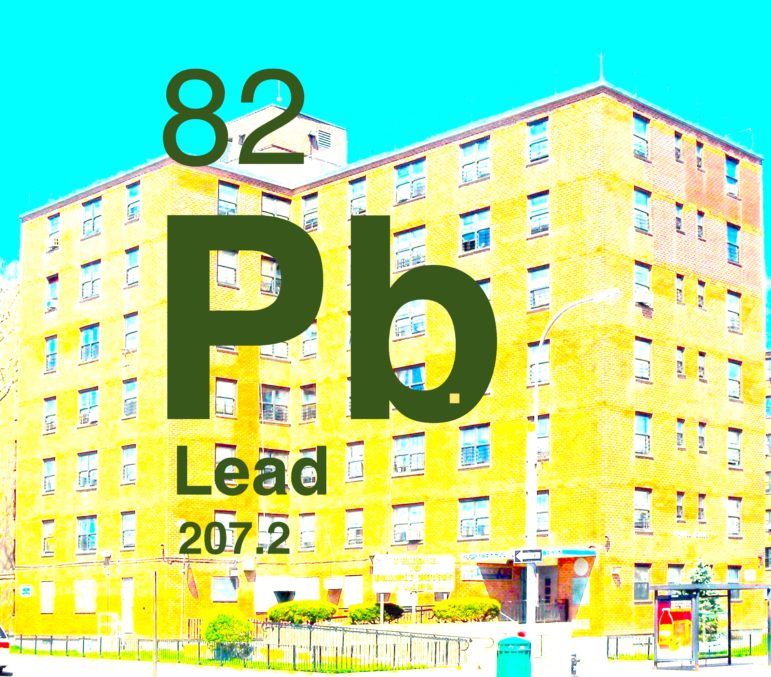
City Limits/Jim Henderson
The best way to end childhood lead poisoning is to rid the child’s environment of lead before he or she is exposed. But lead is so pervasive – hiding in layers of old paint, pipes, dirt on the ground and imported cosmetics and spices – it’s nearly impossible to eliminate it entirely.
The city’s latest raft of lead bills, passed last week, implement some of our country’s most stringent standards to better manage lead in the environment and prevent exposure. But to successfully protect our youth and eliminate lead poisoning, the city will need to be vigilant in enforcing the new standards and fostering a culture of compliance with lead laws.
Lead exposure can cause intergenerational harm to families and communities. For many families, lead poisoning is symptomatic of several preventable issues: lack of access to safe, affordable housing, lack of supportive services and financial resources and reduced access to medical care. From lead in school drinking water to lead paint in public housing, cumulative lead exposure is a critical concern. As a matter of environmental justice, we must address lead exposure in a more holistic way. This means combatting the proximate causes of lead poisoning, strengthening the support services that are available to families whose children suffer from the side effects of lead exposure, and instituting systemic changes in how we have historically approached the problem.
The new package of laws seeks to close certain loopholes in the city’s lead poisoning prevention protocols, identify new areas of potential exposure, lower the standards for allowable lead in paint and dust, enhance transparency in agency enforcement, clarify testing protocols and increase public awareness. Advocates for tenants, public health and environmental justice appreciate the city’s renewed concern about lead exposure reflected both in this legislation and the mayor’s recent LeadFree NYC initiative.
While the new legislation addresses some gaps in enforcement, it still leaves in place the basic structure of Local Law 1, one of the nation’s strongest anti-lead exposure laws, passed 15 years ago by the City Council with the goal of eliminating childhood lead poisoning by 2010. Since its passage, the law contributed to a nearly 90 percent decline in the number of cases of childhood lead poisoning in children under age six. However, since 2010 there have still been more than 50,000 children under six with blood lead levels above the Center for Disease Control’s level of concern.
Under Local Law 1, landlords don’t have to get rid of lead paint in apartments until new tenants move in. Meanwhile, to prevent exposure, landlords must regularly inspect apartments where children under six spend time to look for peeling paint that could create dust or paint chips that children might accidentally ingest. Any renovation work that could create lead paint dust must be done safely. However, it’s clear that many landlords are not complying with this preventive scheme because children are repeatedly getting poisoned in apartments that should have been inspected or had paint abated when prior tenants moved out.
Our 2018 study, “Lead Loopholes” showed that when landlords do not conduct regular inspections or perform lead paint abatements prior to renting apartments, they rarely face any consequences from the city. Those consequences instead fall to families, who suffer when children are exposed to lead paint that should have been removed.
Get the best of City Limits news in your inbox.
Select any of our free weekly newsletters and stay informed on the latest policy-focused, independent news.
City legislation can only go so far in creating a culture of compliance among landlords, who are entrusted with managing and preventing the risk of lead exposure under our system. Landlords need to know that agencies are watching and will penalize them if they neglect to take basic steps to prevent serious harm to their tenants. The city’s LeadFree NYC initiative has announced several actions to help instill a culture of compliance, including targeted audits of landlords who have had lead violations in the past, as well as on online certification system for landlords to promptly notify the city of completed inspections. Combined with the higher standards and increased transparency around enforcement mandated by the Council’s new legislation, there is hope for making progress toward ending lead exposure. But additional legislative measures are still necessary to meet that goal.
We cannot allow another generation of children to suffer the consequences of lead exposure. We must foster a culture of interagency cooperation, transparency and community support to ensure safety for all of our children. We must do right by them.
Rachel Spector is the director of the Environmental Justice Program at New York Lawyers for the Public Interest and Christine Appah is the senior staff attorney in the Environmental Justice Program at New York Lawyers for the Public Interest.









2 thoughts on “Opinion: City’s New and Tougher Lead Laws Demand New and Tougher Enforcement”
‘Lead-based paints were banned for use in housing in 1978. All houses built before 1978 are likely to contain some lead-based paint.’
https://www.cdc.gov/nceh/lead/tips.htm?s_cid=cs_281
Pingback: City Limits Publishes Op-Ed By NYLPI Attorneys on Lead Enforcement - New York Lawyers for the Public Interest